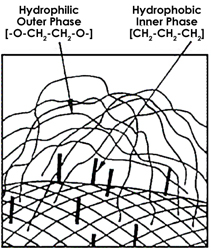SPS (Semi-Permeable Surface) Series

|
In an effort to extend the applicability of the RAM Direct Injection columns, Regis, in conjunction with Dr. Fred Regnier and Dr. Carla Desilets at Purdue University, developed the Semi-Permeable Surface (SPS). Their initial work involved the adsorption of oxythylene detergents onto reversed phase silica to act as shielding agents, protecting the inner chromatographic surface. The material worked effectively, but the detergent layer slowly leached from the silica. Regis Technologies improved the design by covalently bonding a polyoxyethylene polymer to the silica, creating a more stable outer phase. The result was a new, longer-lasting SPS material. Like the ISRP phase, the SPS phases consist of both hydrophilic outer and hydrophobic inner surfaces. The distinct difference is that the inner and outer surfaces of the SPS are bonded separately, allowing each to be varied independently. The SPS structure includes a hydrophobic inner phase such as ODS, and a hydrophilic outer phase of polyethylene glycol (see image below). The outer phase provides size exclusion and hydrophilic shielding, which repels large biomolecules. The various inner phases allow for separation of small analytes. The retention mechanism of these SPS phases involves hydrogen bonding by the outer phase and hydrophobic interaction by the inner phase. Polar solutes interact primarily with the outer phase and show little discrimination among the various inner phases. Conversely, the enonpolar solutes interact primarily with the inner phase. The SPS phases allow use of buffered, normal-phase, and reversed-phase eluents. The actual composition is limited only by the pH and organic modifier parameters dictated by the proteins contained within the sample. Applications |

|
